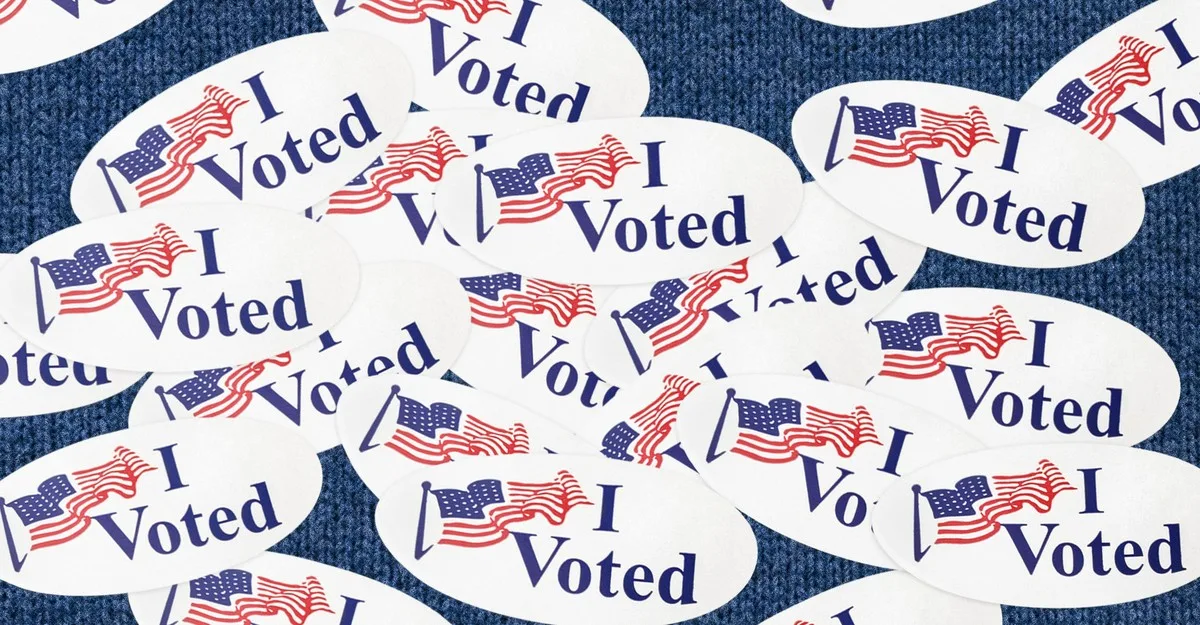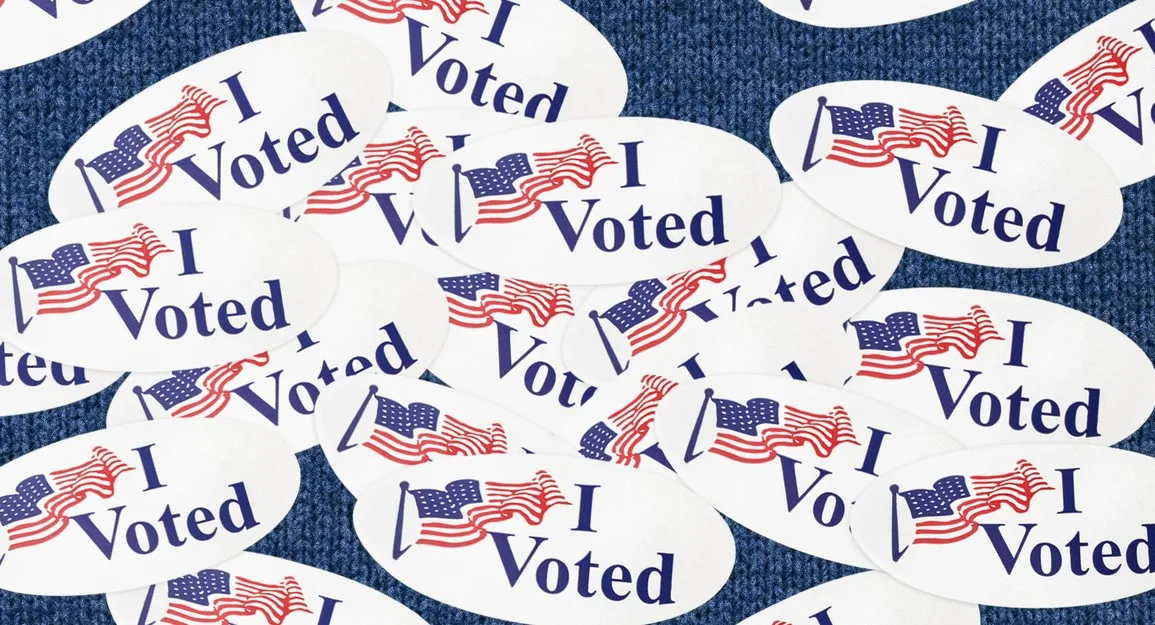
It’s always election season in America. Dozens of local contests are taking place across the country this month, from Montgomery, Alabama to the Mariana Ranchos County Water District in California. On August 8 alone, Custer County, Colorado held a recall election for a county commissioner; Ohio asked residents to consider a major ballot measure; and voters in Oklahoma weighed in on several ballot measures.
America has roughly 90,000 local governing bodies, and states do not—at least publicly—track all of the elections taking place on their watch, making an exhaustive accounting nearly impossible. In many cases, contests come and go without any local media coverage, either. I came across a notice for an August 29 election in Marin County, California. When I called the Registrar of Voters for more information, the county assistant had to search a few moments before he could tell me that the town of Tiburon (population 9,000) was selecting a short-term council member.
Jerusalem Demsas: Trees? Not in my backyard.
Americans are used to pundits and civic leaders shaming them for low-turnout elections, as if they had failed a test of civic character. Voters are apathetic, parties don’t bother with the hard work of mobilization, and candidates are boring—or so the story goes. But this argument gets the problem exactly backwards. In America, voters don’t do too little; the system demands too much. We have too many elections, for too many offices, on too many days. We have turned the role of citizen into a full-time, unpaid job. Disinterest is the predictable, even rational response.
“One of the unique aspects of the electoral process in the United States is the sheer number of decisions American voters are asked to make when they go to the polls,” three political scientists argued at the turn of the millennium. “In any single election, American voters face much higher information costs than the citizens of almost any other democracy in the world.”
These information costs are immense. Americans are asked to fill numerous and obscure executive, legislative, and judicial positions, and to decide arcane matters of policy, not just on the first Tuesday in November but throughout the year.
How are we expected to know how the roles of our mayors and city councils are distinct from the roles of county executives, county council members, treasurers, controllers, and boards of supervisors? On what basis should we choose our coroners, zoning commissioners, or commissioners of revenue? Who should we punish when things go wrong? Reward when things go right?
And how can we keep up with the details of hopelessly complicated policy questions? Ohio’s aforementioned August 8 ballot measure proposed raising the threshold for changing the state constitution. It failed 57 to 43 percent, or roughly 1,700,000 to 1,300,000. This apparent matter of process attracted an unusually large number of voters because Ohioans understood that they were engaging in a proxy fight over abortion; advocates expended significant time and energy to explain to the general public what the ballot measure was really about.
Read: The abortion backlash reaches Ohio
Usually, however, voters are expected to puzzle out even quite complicated issues without the benefit of a government-sponsored education campaign or significant explanatory reporting. In 2022, Georgia voters were asked to approve a statewide ad valorem tax exemption for certain equipment used by timber producers. California has repeatedly asked citizens to vote on regulatory requirements for kidney-dialysis clinics.
Americans are asked to vote too much, and Americans are asked to vote too often. One of the most pernicious ways politicians overburden voters is by holding off-cycle elections. Making time to vote is harder for some people than others; it’s harder for people with inflexible job schedules and needy dependents, for instance. Employers are used to making accommodations for presidential elections—but some random election over the summer? Hardly. As a result, off-cycle local elections are heavily weighted toward higher-income voters, more so than are statewide and national elections.
They’re also heavily weighted toward senior citizens: The most important factor for predicting who votes in city elections is not class or education or race, but age. An analysis by Portland State University’s “Who Votes for Mayor?” project found that people over the age of 65 who live in the poorest, least educated parts of a city typically vote two to five times more frequently than 18-to-34-year-olds in the most educated, affluent parts of a city. Overall, city residents 65 and older were 15 times more likely to vote than those ages 18 to 34.
Ohio Republicans knew that by scheduling the constitutional ballot measure in August, they could dampen turnout and benefit their side. Ohio Secretary of State Frank LaRose, a Republican, had vocally opposed off-cycle elections as recently as December 2021. While testifying in a legislative hearing, he’d pointed to the record voter turnout in November 2020, when “74 percent of all registered voters made their voice heard.” Off-cycle elections, LaRose warned, mean that “just a handful of voters end up making big decisions.” He argued persuasively that “the side that wins is often the one that has a vested interest in the passage of the issue up for consideration. This isn’t how democracy is supposed to work.” State Republicans voted last year to eliminate most August special elections.
But LaRose, who declared his candidacy for the U.S. Senate last month, supported the timing of the August 8 ballot measure, arguing that a statewide issue is “very different” and “not unusual.” According to local Ohio reporting, “There have been only two August statewide votes regarding the constitution”: in 1874 and 1926.
Nostalgic political commentators long for the bygone days when American democracy still worked. But election-timing manipulation has always been a feature of American local politics. The UC Berkeley political scientist Sarah Anzia looked at the timing of local elections in New York, San Francisco, and Philadelphia over the course of the 19th century and concluded, “Election timing manipulation was a common event.” Politicians exploited timing as a way to “exert some control over the electorate.”
For example, in 1857, New York’s nativist Know-Nothing Party and its Republican Party, which controlled the state legislature, bumped the city’s voting schedule so that municipal elections would no longer take place alongside federal ones, but a month later, in December. All of the Democrats voted against the change in part because they feared that it would hurt their mayoral candidate’s chances. (City Democrats knew their voters would show up for state and national elections, but that in a lower-turnout environment, their opponents could out-organize them.) They were right to be scared: Their mayoral candidate lost that very same year.
Off-cycle elections continued, and voter turnout in the city’s elections “consistently fell far below turnout levels in gubernatorial and presidential elections,” according to Anzia. By 1868, more than 155,000 votes were cast for governor in the November statewide election; a month later, just 96,000 people turned out for the mayoral contest. When the city went back on-cycle in the 1870s, voter turnout for the mayor’s and governor’s races reached near parity.
Americans rationally respond to such intense and random demands on our time by simply checking out. In November 2021, just 23 percent of eligible active voters in New York City cast a ballot for mayor. That same year in North Carolina, 463 municipalities held elections, comprising 890 contests and more than 2,500 candidates. All told, about 15 percent of registered voters turned out.
America’s voting problem is primarily a local one. When compared with that of peer nations, our general-election turnout is actually middle-of-the-pack. And although more voting at the federal level is desirable, some political-science research casts doubt on whether the results of national elections would significantly change if everybody showed up. Not so in local elections, where the electorate is remarkably unrepresentative.
In 2020, the year before that dismal local turnout in North Carolina, about 75 percent of voters—five times as many people—turned out for the general election and statewide contests. And in 2022, 51 percent of registered voters, or nearly three and a half times as many people as the previous year, turned out for the statewide election. The “Who Votes for Mayor?” project examined 23 million voting records in local elections across 50 cities, and came away with alarming findings: In 10 of America’s 30 largest cities, turnout didn’t exceed 15 percent. In Las Vegas, Fort Worth, and Dallas, turnout was in the single digits. Portland, Oregon, was the only city in the sample that saw the majority of its registered voters turn out, probably because Portland regularly votes for mayor on the federal-election holiday in November. The city’s special elections are more in line with national trends: In November 2019 and May 2023, voter turnout was only about 30 percent.
The failed Ohio ballot measure is an instructive case study in the low expectations Americans have for voter engagement. In the days following the election, newspapers proclaimed it a “boost for democracy.” A Columbus Dispatch article noted “high participation” and quoted a spokesperson for the Association of Elected Officials who marveled that “so many people turn[ed] out,” deeming the results “the will of the people.”
Relative to other ballot measures, sure. But only about 38 percent of Ohio’s registered voters cast a ballot, a proportion that shrinks to roughly 34 percent when you include all citizens of voting age. Regardless of whether you support the outcome, is it laudable that, on major questions, just a third of voters bother to weigh in?
The minority who do vote end up with disproportionate power. In Tarrant County, Texas, a judge recently told a meeting of the conservative True Texas Project how just 75 people could make a big difference in local elections where “the turnout is so low by percentage … By you bringing neighbors, friends, picking up the phone, doing postings on social media, there are races that, quite frankly, we ought not to be able to win that we can probably win just because we raise awareness and get people out.” At least two candidates endorsed by the True Texas Project ended up winning their races in Fort Worth. In a city of almost 1 million, fewer than 43,000 people cast ballots.
Aligning local elections with national ones would increase turnout and likely create a more representative electorate, but just filling out a ballot doesn’t constitute meaningful accountability. That’s in part because most races at the local level go uncontested: In 2020, 61 percent of city races and 78 percent of county races were uncontested, as were 62 percent of school-board races and 84 percent of judicial races. Even when a race is competitive, finding reliable information about local candidates can be nearly impossible, turning voting into an exercise in randomness or, at best, name recognition.
Incumbents have a staggering advantage in local races. In a 2009 paper, the legal academic Ronald Wright reviewed election data for prosecutors, a role that is both well understood and highly important to voters. (Public safety and crime regularly rank at the top of voters’ list of concerns.) Wright observed that when district attorneys run for reelection, they win 95 percent of the time and run unopposed in 85 percent of races.
This month alone, I found three elections in Delaware that were canceled because not enough people were running. In each case, the candidates who bothered to file simply ascended to their theoretically elected positions. In local government, elected office is apparently first come, first served.
Nature abhors a vacuum: Where voters disappear, special interests rush in. In the absence of regular voter direction, our local elected officials are not directionless. Instead of democracy, what we’ve got is government by homeowners’ associations, police unions, teachers’ unions, developers, chambers of commerce, environmental groups, and so forth.
“All is not well in local government, and it hasn’t been for some time,” Anzia writes in her book Local Interests. Anzia finds, unsurprisingly, that pressure from interest groups works. Political activity by police and firefighters’ unions correlates with greater spending on their salaries, and cities with more politically active police unions are less likely than cities with less active ones to have adopted body cameras. In cities with strong environmental groups, Anzia found, winning candidates are significantly less likely to favor policies conducive to economic growth. And in school districts where teachers’ unions are the dominant interest group, jurisdictions that hold off-cycle elections pay experienced teachers more than those that hold on-cycle elections.
These specific policies may be good or bad. That’s not the point. The point is that the government should act according to public need, not based on who has the money, time, and will to create and sustain an advocacy group.
Blaming the voters is easy: Democracy is on the line; people need to get up off their asses and vote! The problem isn’t the system; it’s the people. Maybe if they saw one more Instagram infographic or heard one more speech about the importance of civics, they would become regular voters.
Putting aside the moral status of nonvoters, this argument is pure fantasy. As the political scientist Robert Dahl once quipped, “Like other performers (including teachers, ministers, and actors), politicians and political activists are prone to overestimate the interest of the audience in their performance.”
Contrary to what good-government types may wish, few Americans want to be full-time political animals. Most of us have absolutely no desire to learn what our county commissioners or district attorneys are up to, let alone take on the herculean task of evaluating their records. Effective representational government must empower voters to hold their elected officials accountable without sucking the life out of its citizens. Even the most dedicated participants in local politics aren’t experts in everything, just in the parts of local government that provide them with benefits they find meaningful.
When ordinary voters do show up in local politics, they’re not walking onto an even playing field. Individuals who become motivated to seek criminal-justice reform after an unjust killing by a police officer, or parents who feel compelled to change school curricula, are entering unfamiliar territory that has been landscaped by special interests. And elected officials know that a flurry of political activity can die out quickly, while interest-group activity remains constant.
When I ask local government officials about this problem, I usually hear denial or resignation. “Nonsense,” Kevin Bommer, the executive director of the Colorado Municipal League, told me a few months ago when I asked him whether he worries that low voter turnout yields an unrepresentative government. He suggested that this view calls “into question not only the legitimacy of a municipal election but the integrity of the people elected, as if they don’t represent their community. Those are the things that academics and people say that have never been to a city-council meeting and don’t go to planning-commission meetings.”
Steven Waldman: The local-news crisis is weirdly easy to solve
I don’t doubt that most local officials have integrity. Many if not most of the local officials I’ve spoken with are kind, hardworking, and genuinely committed citizens. They are pledging their efforts for very few benefits and are forced to face ire and controversy as they serve their communities. But our system shouldn’t depend on the benevolence of local officials. In a healthy democracy, it should depend on the electorate holding local officials accountable through the ballot box.
Giving power to the people is sometimes conflated with giving people more access to government decision making through, say, community meetings or ballot measures. But if only a small, unrepresentative group of people are willing to be full-time democrats, then that extra ballot measure, election, or public meeting isn’t more democracy; it’s less. Most of us are part-time democrats. That’s not going to change, and political hobbyists should stop expecting it to.



